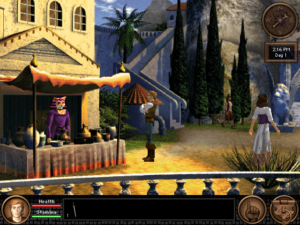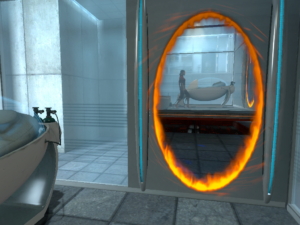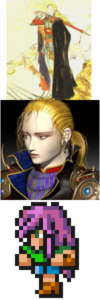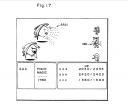Portal is a game I’ve been wanting to play for a while. Despite a low-profile release, all the critics had a lot to say about it, and it’s easy to see why: it’s a very experimental work, as novel in content as it is in gameplay. What we have here is a very dark vision of the future, but unlike the usual videogame dystopia, this darkness is not used as a pretext for wanton violence. Not only is there no support for violence in the user interface, there isn’t even anyone to commit violence against — the only other character you have any dealings with is the artificial intelligence that sets you on your path and urges you on.
Like any true experiment, Portal has its origin in an argument. A programmer made the perhaps obvious assertion that computer games require interactive content — that “the player has to have a direct impact on what’s happening”. Note that this is not necessarily a property of games in general: in some children’s games, such as Chutes and Ladders, the outcome is entirely up to chance and the players are only required to fulfill mechanical duties, like rolling dice and moving tokens. But in a computer game, automatic chores of this sort are naturally left to the computer, which leaves the player nothing to do except exercise agency. This seems like a pretty solid argument to me, but Brad Fregger, Portal‘s producer, felt otherwise.
As a proof-by-example of Fregger’s thesis, Portal fails in two seemingly contradictory ways. To explain this, I’ll have to describe its gameplay a little. The player’s window on the gameworld is a terminal to a global data network. Because the game was written in 1986, the designer’s idea of a global data network doen’t look much like the Web, with its anarchy of links. Instead, it’s a hierarchical structure, with a main interface that gives you access to twelve “data sources”, including your AI helper, a raconteur program called HOMER which specializes in turning data into stories. Each data source has its own list of documents on different topics, and reading some topics (or groups of topics?) will cause new topics to appear. Sometimes you’re told outright about a causal link, as when HOMER tells you that he’s persuaded the History node to release new information. Sometimes you can infer it, as when the text mentions a disease you haven’t heard of and you look it up in the Medical database. Sometimes you just have to guess where the new information is. As you go along, HOMER accumulates more and more story until you have an entire novella answering the game’s central mystery: the fate of the human population of now-abandoned Earth.
So, does the player “have an impact”? Unsurprisingly, you can’t have an impact on the revealed backstory: it’s already set in stone. This is presumably what Fregger was thinking about. However, the player’s actions do change the state of the game. When you choose what to read, you make new topics available: that’s a change. The order in which topics become available can vary from playthrough to playthrough, even though the set of topics you have to go through to reach the end is unvarying. It’s not much of an impact, gameplay-wise, but it’s an impact nonetheless.
(Interestingly, the player’s actions have more of an impact within the story. There are really two levels of narrative: there’s the story that HOMER is putting together — the backstory, with a protagonist named Peter Devore — and there’s the story of finding that story, with HOMER as its protagonist. (No, not the player. The player is just the story’s Dr. Watson, except that Watson at least got to narrate.) These stories come together in the end, when HOMER uses what you’ve learned to contact the missing humans and provide them with the “anchor” they need to come home. HOMER can’t reach that point without the player: part of the premise is that there’s some data that HOMER can’t access without human approval. So within the fiction of the story, the player’s actions help bring the humans back. But that’s just a literary device, roughly equivalent to Grover complaining about the reader turning pages, and just as irrelevant to questions of interactivity.)
It should be pointed out that, despite Portal‘s failure on this point, there is at least one example of a computer game that has no interactivity whatever. But it’s arguable whether that really should be classified as a “game”, rather than a “joke” or a “screensaver”.
Which brings me to my second objection: Is Portal really a game? That’s a harder question to answer, but it seems to me that even if it meets some definition of “game”, it violates at least one major expectation of computer games: there is no challenge to it. OK, there’s the small matter of finding new text snippets to read, but that can be easily accomplished by just cycling through all twelve data sources. (Or, really, only eight: four of the nodes are devoted to displaying inscrutable medical charts and the like about all the characters, and seem to be useless for revealing the story.) Although Activision packaged and sold it like a game, they hedged somewhat on whether it actually was one, preferring to call it “interactive literature”. Even that designation is questionable: although the interface to the story is interactive (in the sense that you can affect its state), the story itself is not. It’s composed of the same events, with the same descriptions, in the same in-story chronological order, no matter what you do; the only thing you can alter is the order in which you read about them. This is the kind of borderline case for which the term “ergodic literature” was coined.
But enough about the strange notions behind its creation. How is Portal as an ergodic novella?
Well, as a novella, it’s not bad. It’s potboiler sci-fi, and I’ve certainly read worse potboiler sci-fi. We start with the idea that you’ve been away from Earth for more than a century, and that gives the author an excuse to bring you up to date on a hundred years of social and technological developments: the Unisex movement, the colonization of Antarctica, neurophagic weapons, and so forth. Devore is a Heinleinian supercompetent hero struggling against a world government that (rightly) sees his scientific investigations as a threat to the status quo. The ending is mystical and apocalyptic and campy all at once. I felt it bogged down in the middle, though, when Devore and his associates went on the lam. I suppose that’s supposed to be the exciting part, but the sudden travelogue seems like a distraction from the questions that HOMER and I were supposed to be investigating. We were on the verge of learning the significance of the Psion Equations! I don’t care what ruse the heroes used to slip past ENC security for the fifth time in a row!
That’s just one example of how the story doesn’t fit its context very well. More troubling is that HOMER treats Devore as the story’s hero from the beginning, when all we really know is that he’s somehow responsible for the depopulation of the planet. It would be fine for an omniscient narrator to do this, but HOMER is very specifically not omniscient, and starts off nearly as ignorant as the player. There’s a bit where HOMER repeatedly says “I am a liar”, upset by the amount of extrapolation from scanty evidence that’s been necessary to tell the story. This almost made me expect a twist where Devore’s story is suddenly radically reinterpreted, but no.
And ultimately, I’m just kind of disappointed in Portal‘s use of its format. It bills itself as nonlinear, but that’s only true to a small degree: no matter what you do, you’re going to get Devore’s story in mostly chronological order. I can imagine using the same engine to tell a story with multiple threads that can be explored independently (or semi-independently), but here, even when we get scenes about secondary characters, they’re pinned to Devore’s chronology.
Still, Portal was a significant experiment. In a way, it prefigured the modern Alternate-Reality Game. The text of the game was later published, with some additional framing material, as an actual book, and now I find it’s been put on the web as well, which is probably the best way to experience the content. You’d get the structure of the original game in a more obvious way, and it would be even more nonlinear, and have a better UI. Plus, it more or less settles the “Is it a game?” question: put it on the web as static HTML, and it’s clearly classified as hyperfiction.
 Comments(1)
Comments(1)


